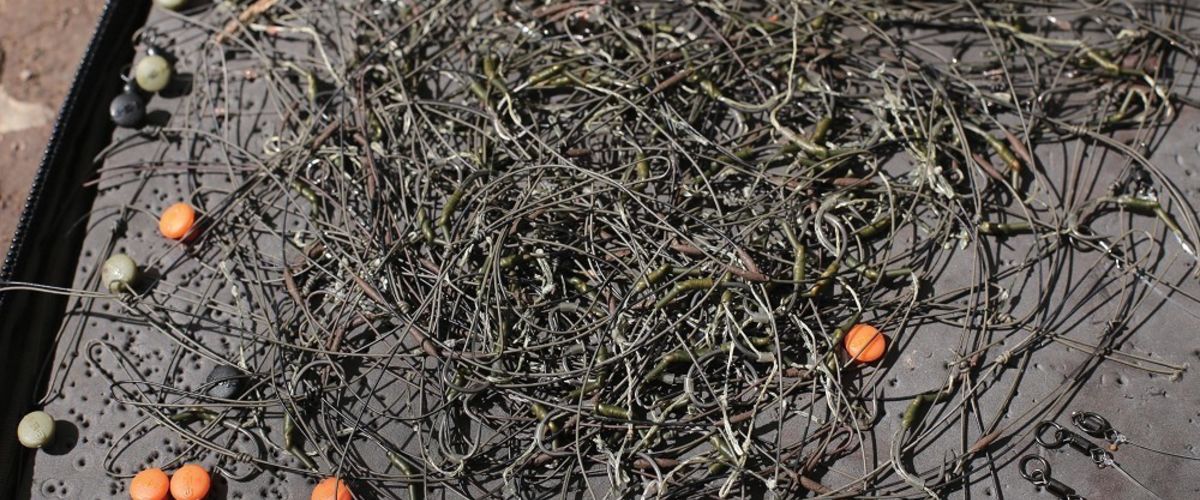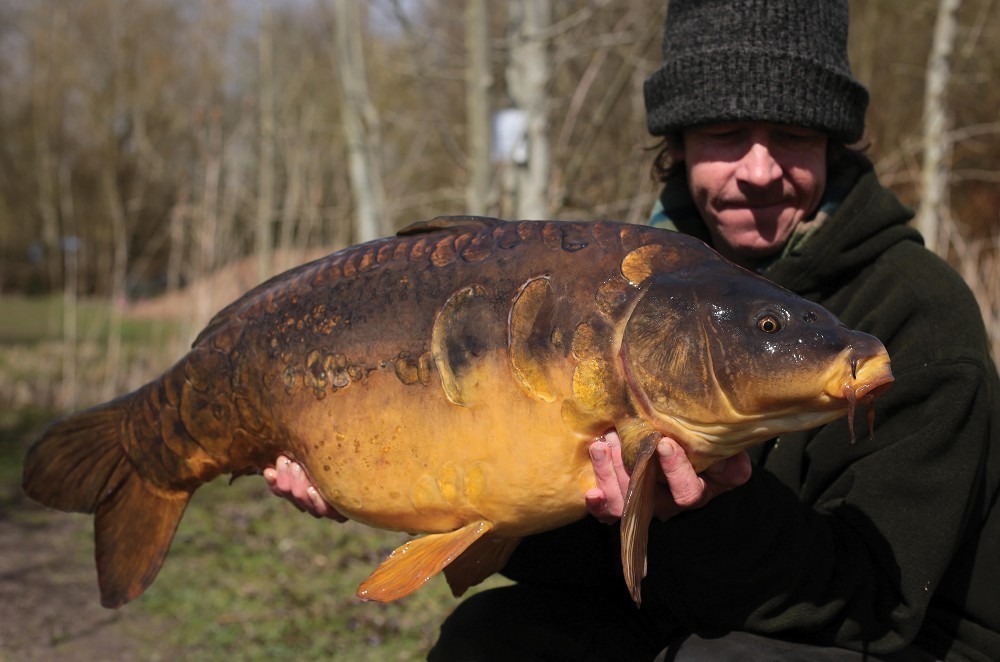
Are we getting done more than we think?
Terry Hearn's Rotary Letter Extension...
Question
I reckon we all get done a whole load more than we think. How many times have we all found fish in the edge, got them feeding and successfully got a rig down there and twenty minutes later they all disappear?! This is exactly the situation we should all actively look for and learn from!
Most times I believe this happens due to the hooklink being too long, even at seven- to eight-inches. When a carp is feeding “bang-on”, it will suck in a mouthful of bait and chew, shift, and spit out without hardly moving. Very few rigs can effectively work too well in this situation. The best edge you can have to overcome this is simply a very, very sharp hook that will nick in place where others don’t.
I have used two-inch hooklinks in the past on waters that you would least expect them to work (heavy, soft silt) but boy oh boy did it work! I cleared up the lake’s stock, catching some two or three times over by August. I suppose it was a case of being a little different but it was also a case of watching how the crafty buggers fed and having the balls to try something that most anglers would have not considered. Jason Hayward
I’d agree with Jason on this one, although a lot of the time if I’ve had fish feeding in the edge and I’ve felt that they’re ‘doing me’, then I’ve still found that they’ve just carried on feeding regardless until all that’s left is the hookbait. Other times I’ve watched them melt away as soon as the first fish has realised it’s a trap.
The best example of this that I can think of was on the Relief Channel in the Lea Valley. One hot summer I’d got into fishing short early morning trips. Basically I’d turn up at first light, bait up a few spots along a long stretch of the channel and then I’d walk up and down checking each spot in turn. The carp in the Relief Channel weren’t pressured, but one particular fish was clearly a bit more clued up than the rest, a mid-thirty mirror known as the ‘Smoked Ham Junky’s Mate’. Yeah, I know, it’s a bit of a mouthful, but this fish was a known big ‘un that had escaped from Broxbourne’s South Lagoon some years earlier, and as such it already knew the score.
My first chance at catching it sticks firmly in my mind. The water was clear and I remember creeping up to the edge, peering through the foliage and seeing it twisting and turning on one of my baited spots no more than five-feet from the bank, nailing every boilie it came across. My kit was a fair way up the path, and so after quietly backing away from the water’s edge I was off and running for a rod and a net. When I got back I could see that she was gone, along with all the freebies, and so I took the chance to quietly lower in my hookbait before sitting down well back, out of sight in the long grass.
I must have sat there a while before patience got the better of me and I slowly edged forward for another look. I could see my single red bottom bait positioned perfectly on the gravel, but a quick scan of the area told me there was nothing about and maybe it was time to lift the rig out and go and check on the other spots. I was just about to do so when suddenly Junky’s Mate reappeared from my right, really tight in to the bank, so I slowly dropped to my knees, all the while keeping my eyes fixed on the fish. It was so close that I saw its eyes swivel as it clocked the hookbait, and its body language changed as it sped up and nosedived straight for it with a purpose, like watching a carp feeding in the old close season, no fear at all. Its mouth kissed the gravel over the top of my hookbait and then just as my hand hovered over the rod and I was expecting it to come up off the bottom shaking its head, it instead bobbed straight up to the surface and bow waved off down the channel without stopping for anything. The line never even flickered and I don’t even think it moved the lead, yet being a canal-like channel I could still see the fish bow waving into the distance when it was fifty-plus-yards from me.
I can think of many more times when I’ve seen fish carry on feeding without fear after ejecting a rig, but on that occasion it was crystal clear that my chances of catching that fish were well and truly blown, for that morning at least. Incredibly it did exactly the same thing the following morning too, on a different spot but with the same rig, and once again it instantly bow waved off up the channel for as far as the eye could see! At the time it was just a simple No Knot rig of around seven- to eight-inches, which certainly wouldn’t have been my first choice today. Watching that fish do the off it was crystal clear to me that ‘it knew’. It didn’t need to see me, hear me, bump into my line or even get pricked, it just knew, and as soon as it did it was ‘outta there’.
As Jason says, the most important part of any rig is the hook, and the sharper it is the better. I read Jason’s Game Changers article a while back, where he shortened his hooklinks right down and made his own big, flat leads, and straight away I could relate it to my own fishing. I could think of one or two venues which I’ve fished in the past where the fish fed in a similar way, and where I think Jason’s heavy drop-off leads, short hooklinks and PVA bag tactics would have done the business. In a way I was kicking myself, as I’d thought along the very same lines at Ashmead, and for a short while I’d even adopted similar tactics, but for one reason or another I got distracted and didn’t stick with it.
On the subject of drop-off leads, I’m fast coming to the conclusion that heavy is only best because they are being dropped soon after getting the pick-up. I’ve only ever done a little bit with the in-line type drop-off system, and good it is too, but in the past most of my drop-off leads have either been tied on with a weak link or fished with lead clips. Either way, they are generally heavy, either 3 or 4oz. The end result is the same: carp pricks itself, shakes its head and drops the lead. It’s in these circumstances that I think a heavy lead is most important, as obviously they help the point to go in further before the lead actually falls off and the carp is left swimming about on a potentially slack line, with no weight dangling down keeping the hook in place. I’m not talking about past the barb as in most cases I don’t believe they go in that far until you’ve actually picked up the rod, but even so, the more of the point that has gone in before dropping the lead, the better.
In one of the last issues I already mentioned how I’ve been tying my leads on, rotary style, i.e. not dropping them, and as mad as it might sound, I’ve had the same three, 2oz lead weights on my rods since last autumn. At Wasing they are nearly always being sent out in a boat anyway, so in all honesty I could use whatever size leads I want. I’d use 6oz leads if I felt they were going to catch me more, but I know that’s not the case. If I was dropping my leads then I’d definitely be going for heavier ones to ensure that the weight has done its job before falling off, but as I’m not dropping them I’m happier with smaller leads, safe in the knowledge that the hooklink is kept under tension anyway, even if the main line has slack in it.
Of course, a heavier, permanently tied on lead might initially do an even better job, but like so many things in carp fishing there’s a trade-off, and in this case that trade-off happens between getting the take and playing it in to the bank. Heavier leads tend to lock up in weed more easily, and I’m sure we’d all agree that we’d rather not have a heavy lead bouncing about on the end when playing in a fish. Unless I’m dropping my leads then I prefer to use weights up to a maximum of 3oz, but for many reasons, 2oz is often my happy medium. Like I say, there are always trade-offs to take into account and when casting that also includes things like disturbance and feeling for drops. With my own rods I find it easier to feel for a drop with leads of 3oz and below as they still enable me to keep a relatively straight rod tip as the leads fall through the water. A bent tip is a less sensitive tip, and personally, anything above 3oz feels clumsy to me. If I was using pokier rods then I might feel differently.
I wrote a bit early last winter on how I’d enjoyed a good ratio of landed fish to takes, when I was fortunate enough to land 36 on the bounce, all whilst not dropping my leads. This was at both Wasing and the Oxford Estate Lake. I don’t like writing statistics as they can come across wrongly, but in this case it’s perhaps worthwhile as it shows a very clear picture, not just in regards to not dropping my leads, but also in terms of
rigs and hook sharpness. Admittedly I did drop a couple out of the next 30 takes between that first good run without any losses and the end of December, but I could hardly moan. We’re always going to lose the odd one, especially with bottom baits and where presentation might not be as clean as we imagine.
The next part might sound unusual, it’s certainly unusual in my own fishing anyway, but it’s the truth. Between that last loss at the end of December and early May, I managed to land 64 takes on the bounce, i.e. no losses whatsoever, and many of the fights were lengthy affairs too, due to fishing at range. Throughout that period I made sure to keep everything exactly the same – consistency was key. Up to a dozen rigs at a time were tied, all identical in length. I tended to bait all three hooklinks together too, which gave me a comparison, and if one hook didn’t feel quite as super sharp as the other two then I always made sure to have so many spares ready that simply looping on another was always done without a second thought, no matter how slight the doubt was. They were all sharp, but I wanted the very sharpest of the sharp on every single time, on every rod. I’m sure that maintaining that kind of fussiness with my hooks, combined with not dropping the leads and well balanced tackle, was what helped me to land so many on the trot without a loss. Keep catching ‘em.




